The following article and recipe were featured in the You Can Ferment That! column in the March/April 2023 Zymurgy magazine.
By Amahl Turczyn
As a follow-up to fermenting kimchi at home in the Jul/Aug 2020 issue of Zymurgy, this is how to make one of the most popular sauces in Korean cuisine, and a key ingredient in kimchi. Gochujang is as ubiquitous to Korean culture as ketchup is to ours, but it’s more of a base seasoning for cooking than a condiment. It is usually either cooked with food or used as a marinade ingredient. As such, it’s a building block for soups, stews, chicken wings, seafood, galbi and bulgogi.
While gochujang is very easy to find at Asian markets, where it is typically sold in bright red plastic tubs, the homemade version has a much more complex flavor, you can tailor the heat level to your liking, and you can avoid the heavy sweeteners (commonly rice or corn syrup) commercial producers use. The bad news is, like home-fermented red miso, it takes time to ferment traditional gochujang—count on two to three months at least, though it will continue to improve beyond that.
Another reason to ferment your own version of this versatile chile paste is that, as a homebrewer, you probably already have one of the key ingredients at home—barley malt. This provides an earthy, grainy base for the ground soybeans and chile peppers used, without getting things too sweet. Coarse-milled malt, husks included, are basically mashed with warm water to convert the starches to a liquid barley wort and then concentrated by boiling the liquid down, reducing it by about half. Sounds familiar, right? And for a faster version, you can skip the all-grain mash and just use unhopped, diastatic pale malt extract. You need those active enzymes intact, since part of the process involves conversion of one of the other main ingredients, namely glutinous rice powder. Also called “sweet rice flour,” glutinous rice powder is easy to find at Asian markets, and goes by the name of chapssal garu (찹쌀) in Korean.
Coarse-ground malted barley is called yeotgireum (엿기름), and it has several culinary applications in Korea beyond brewing beer. For a 3-quart (2.8-liter) batch of finished gochujang, you will need about 4 liters of fairly thin (SG 1.036) wort. When using milled, malted grain or yeotgireum, you would just conduct a one-hour single infusion mash for a highly fermentable wort, and then separate the spent grains from the wort, just as you would for brewing. You may find it easiest to mash in a mesh bag rather than sparge, but do whatever works for you.
If you are using diastatic pale malt extract rather than grain, you’ll want to dilute it to that same strength and volume. To this wort, you’ll be adding a little over a pound (500 g) of glutinous rice powder and letting the wort enzymes work on those starches at about 140°F (50°C) for two hours. It’s best to maintain this temperature during conversion; since it’s a relatively low volume, you can just keep the whole kettle or stockpot in your oven if it can be set that low. Stirring every half an hour helps with conversion but is not strictly necessary.
That’s really the most difficult part of the process; the rest of the recipe is just boiling the wort and converted starch mixture down to reduce it from 4 quarts to 2, and cooling it back down to conversion temperature of about 140°F. Then you add the sea salt, stirring to dissolve. The fermented soybean powder, called meju garu (메주가루) in Korean, and fine-ground red chile powder or gochugaru (고추가루) are added to the sweet, reduced wort liquid next. This forms a thick, sticky paste that should by now be around 100°F (38°C), and it now must be scooped into an appropriate fermentation vessel and allowed to ferment. How thick? The mixture should be thin enough to slowly drop from a spoon, but thick enough that any peaks that form on the surface stay up. Thicker than ketchup then, but not as thick as miso. Suffice to say, your arms will be getting a pretty good workout stirring those powders into a paste of uniform consistency.
For the chile powder, Korean red chile has the most authentic aroma, flavor and color, and you can buy this goun gochugaru (고운 고추가루) in large bags at Asian markets. Make sure to get the fine-grind powdered chile, and you can get a range of heat, from mild to extra spicy. For my batch, I also used homegrown red chiles that I ripened to a full red color, dried in a food dehydrator, and ground to a fine powder with a spice grinder. It’s obviously easier to just use buy Korean chile powder, but the hot New Mexico chiles I used, specifically Lumbre and Rattlesnake varieties, had the spice level I wanted. (Plus, it gave me a good excuse to use my heavy-duty grinder. I’m kind of a kitchen gadget nut.)
As with other fermented products, salt plays a big role in moderating the speed of fermentation, as well as preventing molds and undesirable bacteria from getting a foothold and spoiling the batch. Traditionally, authentic, coarse Korean sea salt called cheonilyeom (천일염) is used. It undergoes a special process to make sure minerals in the seawater do not make the salt bitter. Supermarket sea salt is fine to use…salt is basically salt. Brands like Maldon work just as well. When the gochujang is transferred to the fermentation vessel, as with miso, coarse salt is not only mixed into the paste, but also sprinkled liberally on the surface to prevent microbes from growing there over its months of fermentation.
You will also need to make sure your fermentation vessel is clean and sanitized before you fill it with gochujang. Traditionally, an onggi (옹기) is used, the same semi-porous pot used to ferment kimchi and makgeolli. The old way of making sure it is sterilized is to fill it with hot coals from a wood fire, which also gives the finished gochujang a subtle smoky flavor. These days, home fermenters can simply invert the vessel over a low gas flame for 5 minutes or so to heat-sanitize it. Once it’s cooled down, you can use a spatula to transfer the gochujang into the vessel, securing the top with a piece of cloth that will allow gas exchange during fermentation while keeping out bugs and dust.
Diehard gochujang traditionalists maintain that the top of the vessel should also be exposed to direct sunlight for extra mold prevention. This, however, isn’t practical unless you have a specially made vented glass top for the purpose; the glass top keeps out rain and allows in sunshine, while the vented mesh sides let in air. It’s an ingenious invention to be sure, but not strictly necessary. I prefer to ferment indoors in my cool basement, with just the cloth cover secured with a rubber band. It takes longer, but it seems somewhat safer than leaving pots of fermenting chile paste out in the yard.
And speaking of fermentation, exactly how will this stuff ferment without a yeast addition? We’ve deactivated the barley malt enzymes with the long boil, so what does the fermenting? It just so happens that the funky-smelling meju garu is probiotic and enzymatically active, and it’s what does the fermentation, although the goal is not to produce alcohol here, but rather to break down starches, lipids, and proteins. Amylase tackles the starches, lipase the lipids, and protease breaks down proteins into umami-rich amino acids such as glutamate and aspartate.
It’s very similar to the fermentation process for Japanese miso, which also uses soybeans as a protein base—in that process, koji (Aspergillus oryzae, a food-friendly species of mold) provides the necessary enzymes. For gochujang, that’s why the cooling step after boiling to reduce the sweet wort is very important—you want to avoid stirring in your meju garu until the wort is cool enough to not deactivate the enzymes in the fermented soybean powder.
That’s about it! You should be ready to make your own batch now.
Considering that koji, like barley malt, contains amylase, I decided to take things one step further. As an experiment, I milled about a half a pound of red wheat malt into a fine powder using a Mock Mill Kitchenaid attachment (yep, another kitchen gadget) and added it with the meju garu. Since the barley malt enzymes had been deactivated, I figured this batch of gochujang could use a little extra amylase. It’s not traditional, and just realize that there is a slight risk anytime you eat any raw agricultural product*, but I was happy with how this batch turned out. The recipe accompanies this article. Happy fermenting!
*Rodent feces occasionally turn up in bags of brewer’s malt—the FDA allows for a small percentage in many food products—but hantavirus, salmonella, leptospirosis, listeriosis, tularemia, and meningitis are just a few diseases that can result from human ingestion. It’s rare, but it happens. Something to keep in mind next time you brew that raw, no-boil ale!
Amahl Turczyn is associate editor of Zymurgy.
Gallery: Making Gochujang
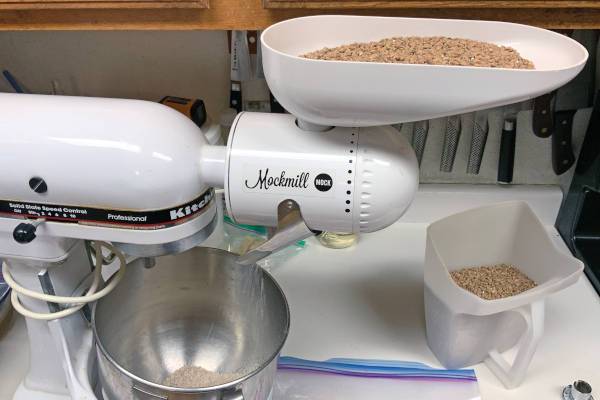
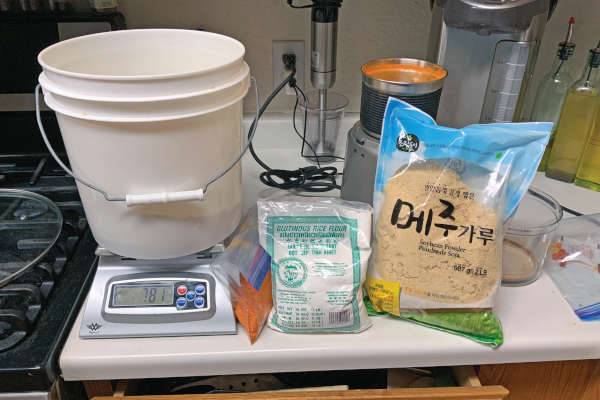
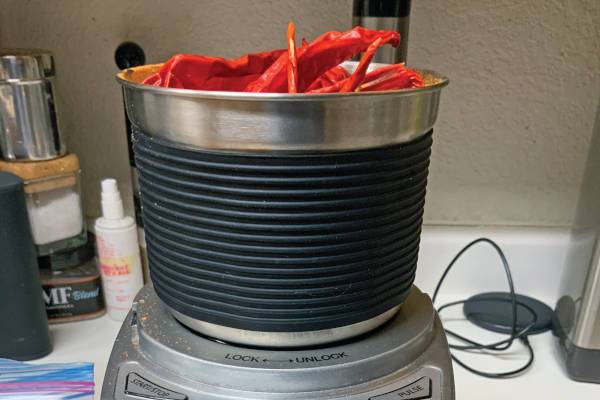
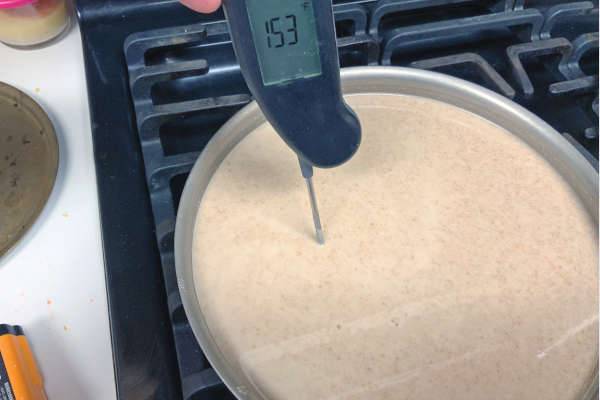
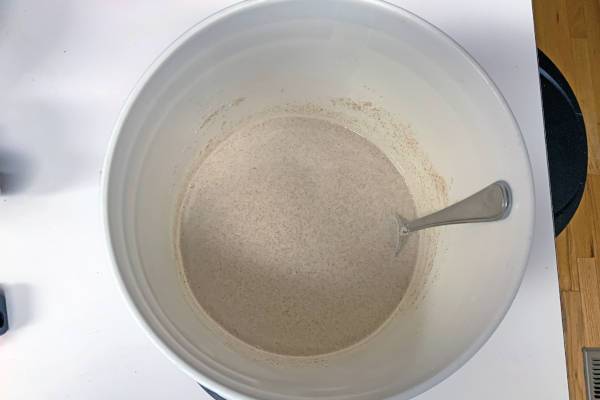
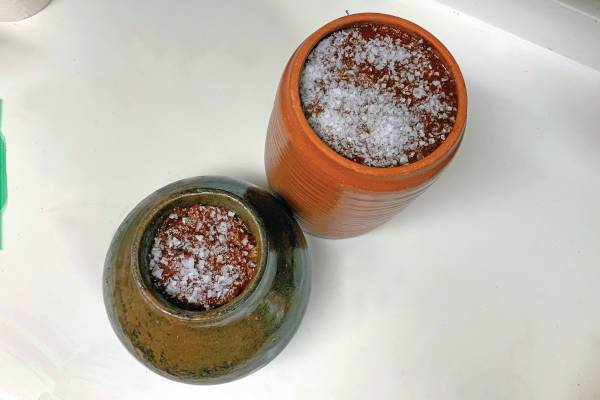
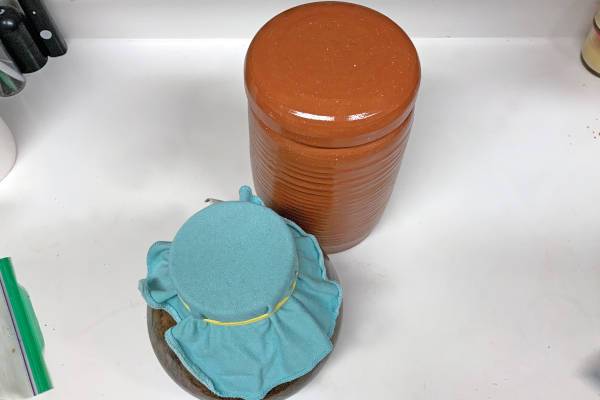
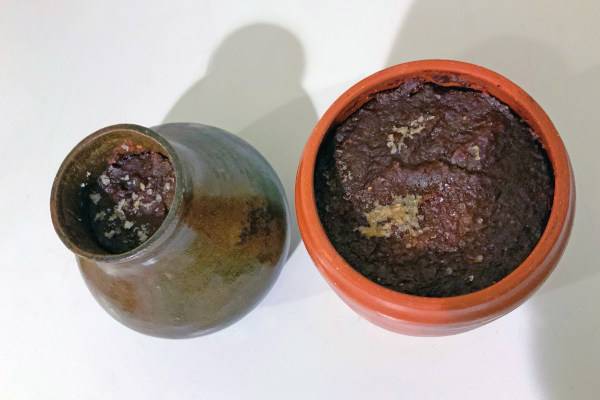
Gochujang Recipe
Batch Volume: about 3 qt. (2.84 L)
EQUIPMENT
- 6-liter kettle (for barley wort)
- BIAB mesh brewing bag (optional)
- large mixing bowl
- long wooden spoon (for mixing in powders)
- large onggi or similar fermentation vessel (about 3 L capacity)
- mesh or cloth cover, or dedicated gochujang fermentation lid
- oven or other temperature-controlled space
INGREDIENTS
- 500 g (1.1 lb.) milled pale barley malt (yeotgireum)
OR the equivalent amount of unhopped diastatic pale malt extract - 500 g (1.1 lb.) glutinous rice powder (chapssal garu)
- 250 g (0.55 lb.) fermented soybean powder (meju garu)
250 g (0.55 lb.) coarse sea salt (cheonilyeum) - 500 g (1.1 lb.) fine-ground red Korean chile (gochu garu), divided
- 250 g (0.55 lb.) finely milled barley or wheat malt (optional)
PROCESS
Mash enough filtered brewing water with the pale barley malt in a mesh bag to achieve 4 liters of 1.036-gravity wort at 50°C (140°F). (Alternately, use enough pale diastatic malt extract to achieve the same volume and gravity.) Stir in the glutinous rice powder and continue to hold the same temperature until conversion of starches is complete, about two hours. Remove spent grains and bring mash kettle to a boil. Reduce volume to about 2 liters. Cool concentrated wort to below 50°C and dissolve most of the salt into it, reserving a few tablespoons to sprinkle on top of the finished gochujang prior to fermentation.
Wait until the mixture cools to 100°F (38°F) or less, if necessary, and add the fermented soybean powder and ground chile. Add the finely milled malt powder, if using. Blend well. Mixture should be very thick. If peaks fall back into the gochujang, add more chile.
Sanitize the onggi or fermentation vessel. Spatula the gochujang in, sprinkle the surface liberally with the remainder of the salt, and cover with a cloth or breathable glass lid. Ferment in a cool place 2 to 6 months, checking occasionally for mold or other microbial growth. As with miso fermentation, if mold forms, scrape it off, wipe with a food-grade ethanol such as Everclear, and sprinkle the area with more salt to prevent regrowth. When gochujang reaches a satisfactory flavor, it should be stored in airtight containers in the fridge for use.
The post How to Make Gochujang (고추장) appeared first on American Homebrewers Association.
